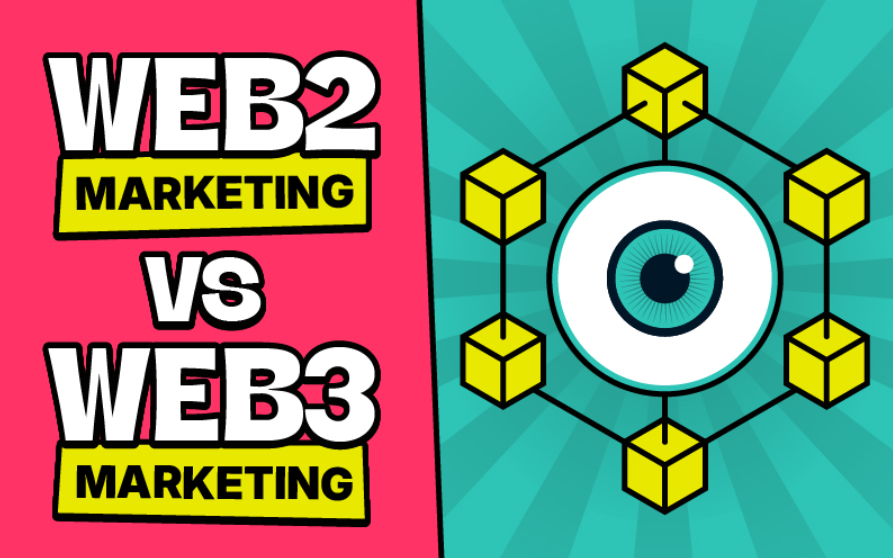
“What important truth do very few people agree with you on?” —Peter Thiel
Web3 represents a multitrillion-dollar industry brimming with immense potential and minimal competition. Yet, the market hasn’t fully recognized its true value. We want to convince you that there is a strong contrarian bet to make in this space.
Starting a business in Web2 today means facing overwhelming competition. There are several reasons for this: markets are mature, demand is high, and barriers to entry are low due to platforms that require little to no coding skills.
Platforms like Shopify and ClickFunnels have democratized the ability to launch a Web2 business. Shopify, founded in 2006 by Tobias Lütke, Daniel Weinand, and Scott Lake, enables anyone to build online stores with ease. This e-commerce platform provides tools that simplify setting up and managing an online retail presence. ClickFunnels, created in 2014 by Russell Brunson and Todd Dickerson, assists entrepreneurs in designing sales funnels to market and sell products effectively. It allows users to create landing pages, handle email marketing, and manage customer relationships without needing extensive technical expertise.
Payment solutions such as Stripe and PayPal make billing customers straightforward and accessible. Stripe, established in 2010 by brothers Patrick and John Collison, offers flexible payment processing software and APIs that integrate seamlessly with various online platforms. PayPal, founded in 1998 by Max Levchin, Peter Thiel, and others, revolutionized online payments by providing secure and user-friendly services that made e-commerce transactions accessible to the masses.
Advertising platforms like Meta, Snapchat, and TikTok allow businesses to reach thousands of customers with targeted ads. Meta (formerly Facebook), started by Mark Zuckerberg in 2004, connects billions of users worldwide, providing unparalleled reach for advertisers. Snapchat, launched in 2011 by Evan Spiegel, Bobby Murphy, and Reggie Brown, offers multimedia messaging and has captivated a younger demographic. TikTok, introduced by ByteDance in 2016, has become a global phenomenon for short-form videos, enabling content to go viral rapidly.
Building an audience has become affordable, even free, if you’re willing to invest time and effort. Platforms like TikTok and YouTube make it possible to grow your following without significant financial investment. YouTube, founded in 2005 by Chad Hurley, Steve Chen, and Jawed Karim, is the world’s largest video-sharing platform, where creators can share content and build communities around their channels.
But despite these opportunities, the landscape is saturated.
You’ll always encounter someone bigger, stronger, or faster than you. Potential customers will compare you to more established brands and businesses. Competitors can outspend you on advertising, effectively pushing you out of the market.
This scenario is known as a red ocean—a market space filled with fierce competition and metaphorical “blood in the water.” What you want is a blue ocean, a market space that is uncontested and full of opportunities, where you can innovate without the pressure of intense rivalry.
The Obvious (And Mostly Empty) Blue Ocean of Web3 Marketing
Web3, in contrast, is much less competitive. It feels almost empty. Tools that allow building without technical skills are scarce, and the technical barrier to entry remains high for both founders and users.
We often say that it’s a game of 300 builders.
Consider the top Web3 developers, entrepreneurs, and business angels. It’s a group of a few hundred people. Web3 influencers, also known as Web3 KOLs (Key Opinion Leaders), play a significant role in shaping this space. These individuals have substantial influence over the NFT and crypto communities, impacting trends in crypto marketing and Web3 influencer marketing.
In Web2, you compete against thousands, if not hundreds of thousands, to become an insider and make an impact.
Everything in Web3 is in its infancy. Almost everything needs to be built. As the popular meme says, “You’re early.” This means there are countless opportunities for innovation and leadership.
Whether you aspire to be a builder, a Web3 marketer, or a business angel, there is plenty of room in Web3. Don’t misunderstand us: free space doesn’t mean free lunch. You’ll need to work diligently, contribute meaningfully, and fit into the culture. You’ll have to build to prove your worth because in this space, people don’t trust—they verify. But the path to making an impact is more accessible here than anywhere else.
In a few years, Web3 will be crowded with builders, big companies, and pure players worth tens of billions. Some big brands like Gucci, Nike, and Starbucks are entering the space but remain cautious.
Gucci, the Italian luxury fashion house founded in 1921 by Guccio Gucci, has begun exploring Web3 by launching NFT collections and accepting cryptocurrency payments. This move signifies their interest in blending fashion with digital ownership and blockchain technology. Nike, established in 1964 by Bill Bowerman and Phil Knight, acquired RTFKT Studios, a company creating virtual sneakers and collectibles. This acquisition signals Nike’s entry into the metaverse and NFT market, showcasing their commitment to innovation in digital assets. Starbucks, founded in 1971 by Jerry Baldwin, Zev Siegl, and Gordon Bowker, introduced Starbucks Odyssey, a blockchain-based loyalty program. This program aims to enhance customer engagement by integrating blockchain technology into their rewards system.
As regulations become clearer, many more will join. Everyone will come to get their slice of the pie—all big consumer brands, entertainment franchises, and financial giants. Billions of people will own crypto and know how to use smart contracts and wallets. At that precise time, becoming one of the three hundred insiders will be almost impossible.
Smart contracts, or simply contracts, are like digital agreements written in code that self-execute when certain conditions are met. Imagine them as automated deals that ensure specific actions occur without the need for intermediaries. They are a cornerstone of Web3, enabling decentralized applications and services.
A wallet is like a digital bank account for the decentralized internet. It’s a secure tool that lets you store, manage, and use cryptocurrencies and other digital assets. Think of it as your personal digital wallet for the blockchain world, allowing you to interact with various decentralized platforms and services.
Right now, it’s possible to become an insider. Maybe you are at the right time and place for the first time in your life. So keep reading, my friend.
The Important Truth That Builders Are Missing and the Market Hasn’t Priced In
Entrepreneur and investor Peter Thiel likes to ask: “What important truth do very few people agree with you on?”
Peter Thiel is a billionaire entrepreneur and venture capitalist known for co-founding PayPal and Palantir Technologies. He was also the first outside investor in Facebook, recognizing its potential early on. In his book Zero to One, he explores how to build companies that create new things, emphasizing the value of unique insights and contrarian thinking.
This question encourages us to think about unique insights that challenge conventional wisdom. Our answer lies within this guide: As an entrepreneur or aspiring entrepreneur, not building in Web3 is a mistake. The same applies to marketers, designers, and developers.
We’re not in 2012 when Bitcoin was an obscure, under-the-radar concept admired by cypherpunks. Crypto is going mainstream. All the big companies are coming. Institutional money is poised to pour into Web3 technologies.
Although Michael Saylor focuses primarily on Bitcoin and is not a proponent of Web3 in general, he made an important point in 2020. Michael Saylor is the co-founder and executive chairman of MicroStrategy, a business intelligence company. In 2020, he became famous for investing billions of dollars of his company’s assets into Bitcoin, making a strong case for its adoption. He observed that Bitcoin was an obvious revolution that the market hadn’t fully recognized yet.
In 2010, Saylor believed that the GAFA companies (Google, Apple, Facebook, Amazon) were in monopoly situations and about to generate unprecedented profits, similar to those seen by John D. Rockefeller and Standard Oil. Yet, the market hadn’t priced it in as of 2010. He saw the same scenario with Bitcoin in 2020.
The objective is broader, because we’re relying on Web3 and not Bitcoin alone. But Saylor’s notion is key to our understanding. Between 2010 and 2017, crypto was an exotic concept with a high failure rate, attracting mostly gamblers and zealots. Crypto and Web3 today are in the “obvious but not priced in, not saturated with builders” phase. Web3 tomorrow will be in the “mainstream adoption, priced in, and saturated with builders” phase.
So you might ask…
Why So Many Are Missing the Web3 Marketing Opportunity?
There are several reasons:
🧱 Volatility. Markets fluctuate violently. Cryptocurrencies like Bitcoin and Ethereum can lose 30% of their value in a single day. This scares investors and builders who prefer stable markets. However, volatility also presents opportunities for those who understand the market dynamics and can navigate the risks.
🧱 Regulatory Uncertainty. You have no idea if the SEC (Securities and Exchange Commission) will sue you tomorrow, and your lawyers might not know how to navigate the legal landscape. The lack of clear regulations makes companies hesitant to enter the Web3 marketing space. Yet, crypto influencer marketing can be highly effective if done carefully within legal boundaries. Staying informed about regulatory developments and working with legal experts can mitigate these concerns.
🧱 Security Concerns. North Korea might hack you and leave you with nothing. High-profile hacks, like the Mt. Gox incident in 2014 where 850,000 Bitcoins were stolen, have made people wary. Web3 marketers need to ensure robust security measures are in place. Implementing best practices in cybersecurity can protect assets and build user trust.
🧱 Lack of Consumer Protection. You have no idea how to process a refund in Web3, as token ownership can change hands many times each day. Traditional consumer protection laws don’t always apply. NFT marketers must educate users on risks and safe practices. Developing user-friendly interfaces and support systems can enhance the customer experience.
🧱 Technological Complexity. Web3 developers can charge high fees, and technologies evolve rapidly. Learning new programming languages and platforms is challenging. But tools are emerging to simplify development, like no-code platforms for Web3. These tools lower the barrier to entry, allowing more people to participate in building Web3 applications.
🧱 Market Manipulation and Rug Pulls. Some people are smarter than you and may not have your best interests in mind. Rug pulls have become notorious in the crypto space, making it essential to work with trusted Web3 influencers and Web3 KOLs to build credibility. Due diligence and community engagement can help identify and avoid fraudulent projects.
🧱 Lack of Mainstream Adoption. Some people say that there aren’t enough users willing to participate. But with big brands like Gucci, Nike, and Starbucks entering the space, adoption is growing. As more recognizable names embrace Web3 technologies, consumer confidence increases.
🧱 Environmental Concerns. You’ve heard that crypto is polluting, and you’re worried your investors won’t like it. Bitcoin mining consumes a lot of energy, but new technologies like Ethereum 2.0 are moving to proof-of-stake, significantly reducing energy consumption. This shift addresses environmental concerns and makes participation more sustainable.
🧱 Legal and Tax Complexities. Taxes are getting clearer, but there are still many legal obstacles. Working with experienced crypto tax professionals is essential to navigate these complexities. Proper planning and compliance can prevent legal issues down the line.
🧱 Innovation Risk. Things change quickly, and you might build something no one needs. But innovation is at the heart of Web3 marketing, and being agile is key. Embracing a flexible approach allows you to adapt to market changes and user needs.
🧱 Assumption of Limited Use Cases. Do people really use wallets and Web3 for something other than gambling? Yes, applications like decentralized finance (DeFi), non-fungible tokens (NFTs), and decentralized autonomous organizations (DAOs) are expanding use cases. These innovations are transforming industries like finance, art, gaming, and governance.
🧱 Difficulty in Accessing Funds. Bringing money into crypto and taking money out can be challenging. Your bank might shut down your account.
🧱 Lack of Courage and Herd Behavior. People wait for others to go first before moving. Being an early mover in Web3 marketing can give you a significant advantage. Taking the initiative allows you to establish yourself before the market becomes crowded.
The good news is that Web3 is experiencing its “Perestroika Moment.”
The Web3 Perestroika Moment
Let’s delve into some “AFK” (away from keyboard) history. Authors of the book Token Titans, Tugan Bara, who is a Web3 marketer and entrepreneur, has a keen interest in what happened in the Soviet Union and Russia from 1985 to 1999.
It might seem unrelated to Web3, but allow us to explain.
In 1985, the Soviet Union’s leader, Mikhail Gorbachev, introduced two major reforms in a last attempt to revitalize the Soviet economy. These reforms were called Perestroika and Glasnost.
Perestroika, meaning “restructuring,” aimed to rebuild the economy by introducing elements of market economics into the communist system. This allowed for some private ownership and entrepreneurship, a significant shift from strict state control.
Glasnost, meaning “openness,” promoted transparency in government institutions and allowed freedom of information and expression. This led to a more open society where ideas could be shared freely, fostering innovation and dialogue.
What happened next is fascinating.
A small group of bold entrepreneurs seized this opportunity to create the first companies after decades of strict communism.
One of these entrepreneurs, Mikhail Khodorkovsky, even created his own bank. The concept originated in 1986, and Khodorkovsky then established one of the first privately owned banks in Russia in 1988, which later became Menatep Bank. This was remarkable considering it was still a communist regime with tight control over the economy.
Because these young entrepreneurs could provide goods and services to anyone, including key party members, they became very wealthy and politically connected.
They were the ones who would become the “oligarchs” a few years later when the Soviet Union collapsed. Thanks to the connections, capital, and experience they accumulated during communism, they could take over significant portions of the Russian economy in the ’90s.
These young entrepreneurs knew an important truth that very few people in the Soviet days agreed with. The risks were extremely high.
In his book The Oligarchs: Wealth and Power in the New Russia, author David E. Hoffman points out an interesting fact. He wonders why so few people seized the opportunity to engage in entrepreneurship during Gorbachev’s reforms.
The answer is that everyone assumed that sooner or later, the hardline communists would oust Gorbachev, take over power, and imprison these mini-capitalists.
“We were aware of the risks. We knew that the hardliners could come back to power and punish us for what we were doing,” said Leonid Nevzlin, Khodorkovsky’s business partner. Despite the fear, they moved forward, recognizing a unique opportunity.
This is the parallel with crypto and Web3.
Why are so few people and companies joining Web3? Because they fear or assume that one day the government will wake up, ban crypto, make holding Bitcoin illegal, and imprison anyone who has built anything there.
In the same way that communists could have stopped entrepreneurship overnight, governments could make Web3 illegal tomorrow.
But this won’t happen because the communists couldn’t stop entrepreneurship in the late ’80s. The reason is simple: in every layer of society, many people benefited from it.
In Communist Russia, working families could have extra income thanks to the small businesses of their children. People had access to more goods and services without waiting for the state to provide them. Even top party members were enjoying the services provided by these entrepreneurs.
It’s the same for crypto. From low-income families to insider-trading-addicted Congress members to entrepreneurs in Silicon Valley, in every layer of today’s society, a growing number of people, for many different reasons, want crypto to stay and succeed.
Crypto is here to stay, and you can be part of it.
Right now, we are in a unique moment where the barriers to entry are low, and the potential rewards are high. Platforms like Side.xyz are paving the way for new entrants to join the Web3 space. Side.xyz provides tools and resources for builders to succeed in their Web3 marketing strategy.
By leveraging the power of Web3 marketing, crypto influencer marketing, and collaborating with NFT marketers, you can position yourself at the forefront of this revolution.
Remember the question posed by Peter Thiel: “What important truth do very few people agree with you on?”
Our answer is: Web3 is the future, and now is the time to build.
Don’t wait for others to show you the way. Be the pioneer. Embrace the challenges, overcome the obstacles, and become part of the next generation of innovators.
Crypto is here to stay, and you can be part of it.





